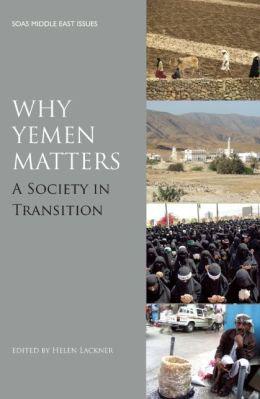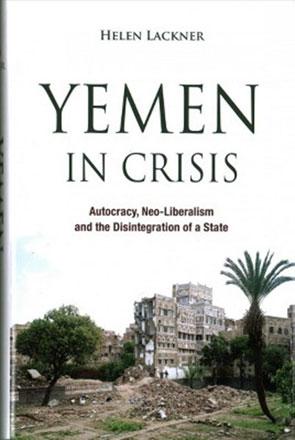You are here
Linking Yemen’s past, present and future
By Sally Bland - Mar 09,2014 - Last updated at Mar 09,2014

Why Yemen Matters: A Society in Transition
Edited by Helen Lackner
London: Saqi Books, 2014, 334 pp
“Why Yemen Matters” is a remarkable book in terms of its comprehensiveness, accessibility and ethical approach. Comprising articles by 18 scholars, many of whom have spent extensive time in the country, it covers Yemen’s politics and economy from the early 20th century to the 2011 uprising and its aftermath, with social issues woven into the overall analysis. Located at the crossroads of two continents and strategic waterways, Yemen’s geopolitical importance is highlighted, as are the regional and international factors that impact on its internal situation.
For a small country, Yemen has a relatively large and diverse population. Its politics are complicated by a range of factors, not least its former division and subsequent unification, and its status as the poorest among oil-rich neighbours, but the contributors navigate these complexities with clearly explained facts. There is sufficient coverage of the past to make the current situation understandable without an overload of historical data. An excellent chronology is provided for those not well versed in Yemeni history, as well as several good maps. The articles are impeccably objective, yet one senses that the authors write out of concern for the Yemeni people’s welfare, not only as academic.
Editor Helen Lackner begins with an overview that, inter alia, traces the roots and special characteristics of the 2011 uprising, and evaluates its outcome, noting, “The peaceful political movement in Yemen was more widespread and long-lasting than anywhere else in the region.” (p. 12) In a tone that can only be described as feisty, Sheila Carapico critiques US “anti-terrorist” attacks on Yemen as “patently contrary to the pursuit of justice, respect for human rights and cultivation of the rule of law” for which Yemenis activists were struggling by peaceful means, despite regime violence. (p. 44) Laurent Bonnefoy gives a fascinating account of the various forces involved in the uprising at different times and places, especially the “shabab” or youths –– very representative as youths account for almost 75 per cent of the population, and the Islamists. Moving to the cultural field, Katherine Hennessey stresses the role of artists, musicians and actors in the 2011 demonstrations, asserting that prior to that, “one of the places that sociopolitical discontent was being most powerfully expressed was on the Yemeni stage” (p. 70). Her review of the topics of contemporary Yemeni plays is eye-opening.
By analysing civil-military relations, Adam C. Seitz explains why the army fractured in 2011, as the regime’s participation in the “war on terror” and divide-and-rule policies backfired, alienating large segments of its political and tribal support base. In a similar vein, Marieke Brandt makes sense of the recurring wars in the Sa’ada area, clarifying the motives of the Huthi revolt after the regime recurrently used tribal militias from the North to fight its battles. In her view, “it was not tribal involvement per se, but rather an erosion of tribal norms that contributed to the brutalisation of the conflict.” (p. 107) Noel Brehony addresses the legacy of the People’s Democratic Republic and how it relates to today’s independence movement in the South.
Successive articles address employment, which is especially acute among southern youth; water scarcity which has reached crisis proportions; land-related disputes –– the most common cause of armed violence; limitations on economic development; and the woefully inadequate healthcare system. Gerhard Lichtenthaler provides a ray of hope by telling how people in some areas have applied tribal customs to enact “local solutions and community self-regulation in dealing with water stress”. (p. 183) Addressing women’s reproductive health, Christian Hellmich contends that contraception is not the solution if not coupled with augmenting women’s social status and decision-making power. This entails revision of laws and state policy since, after unification, “In the bargaining process that has dominated the political sphere since 1994, women’s rights have become the first casualty of politics in a fragile state.” (p. 262)
Two chapters on migration round out the book. The first covers Yemeni migration historically from traders of old, who reached and settled in Indonesia, to more recent labour migrants to Gulf states — and the impact of their return. Less well-known is that Yemen is a migrant receiver state, offering asylum to Somalis fleeing war and chaos, and job opportunities to Ethiopians. The second article covers the Yemeni community in China, seen as facilitators for Yemenis doing business with China — all in the context of substantial Chinese development aid to Yemen over decades.
This book is a must-read for those wanting to go beyond the headlines proclaiming Yemen a “failed state”, in order to learn about people’s daily realities, needs and aspirations. It dispels misconceptions about the causes of Yemen’s problems, such as exaggerating the role of qat, tribalism, Islam or Al Qaeda, to reveal Yemenis as wrestling with problems often beyond their control, but who persist in struggling for a better future.
Sally Bland
Related Articles
Yemen in Crisis: Autocracy, Neo-Liberalism and the Disintegration of a StateHelen LacknerLondon: Saqi Books, 2017Pp.
The Alawis of Syria: War, Faith and Politics in the LevantEdited by Michael Kerr and Craig LarkinLondon: Hurst and Company, 2015Pp.
The Birth of the Arab Citizen and the Changing Middle EastEdited by Stuart Schaar and Mohsine El AhmadiUS: Olive Branch Press/Interlink Publ


















